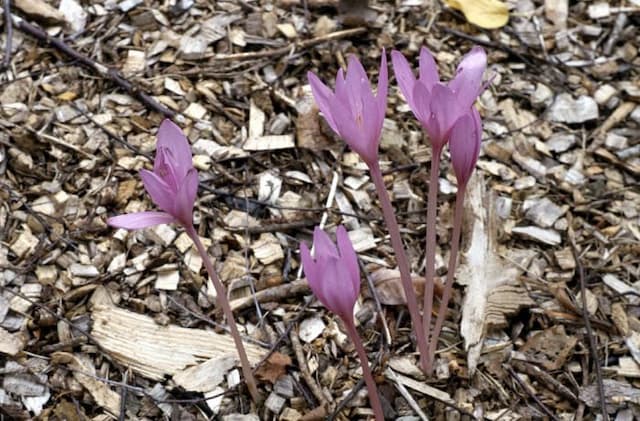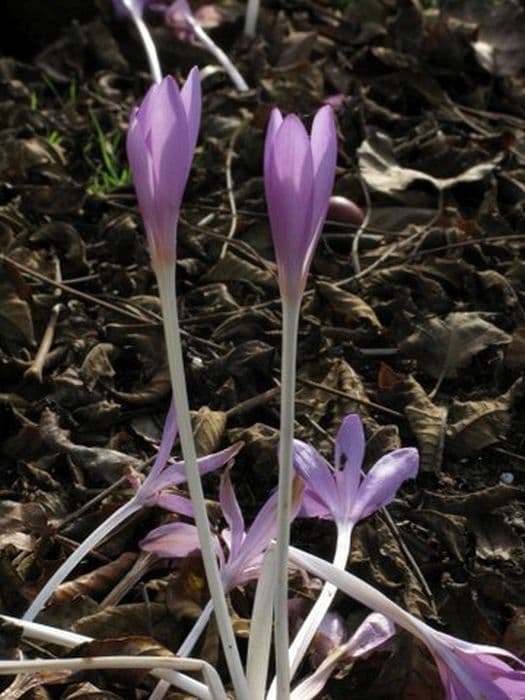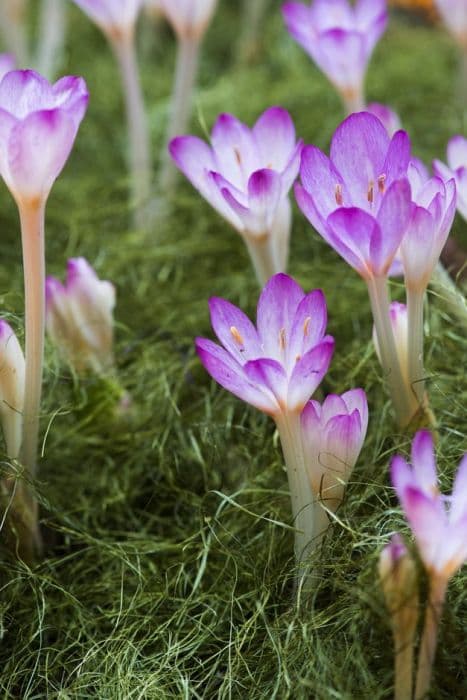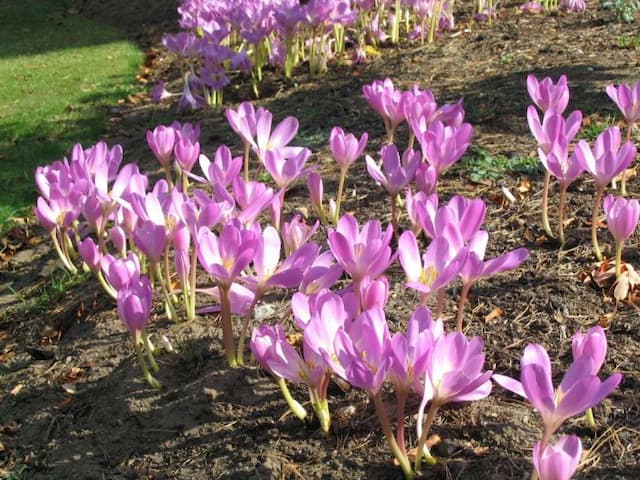Variegated Fairy Bells Disporum sessile 'Variegatum' (v)
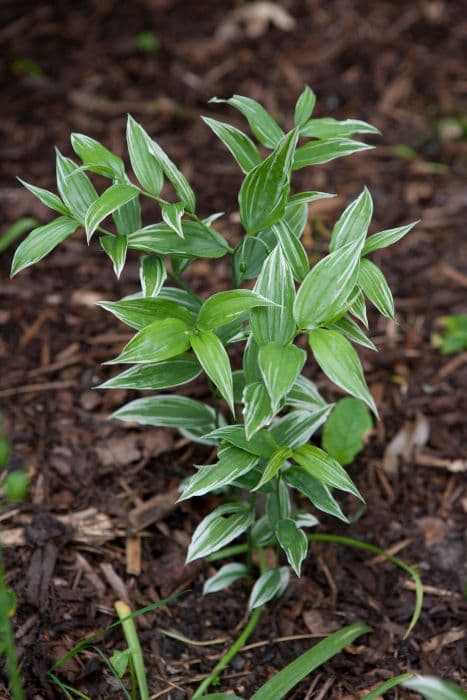
ABOUT
Disporum sessile 'Variegatum', commonly known as the variegated fairy bells, is a visually striking plant that features a beautiful blend of foliage and subtle blooms. The plant is characterized by its stunning leaves, which exhibit a captivating variegation. The predominant color of the leaves is a rich, deep green, but they are artfully splashed with irregular creamy white to yellow markings that seem to dance across the surface. This variegation adds a luminous quality to the plant and makes it stand out in shady garden areas where it is commonly planted. The leaves of variegated fairy bells are elongated and somewhat lance-shaped, coming to a gentle point. They grow in an alternating pattern along the gracefully arching stems, giving the plant a light and airy appearance. Early in the growing season, the plant produces delicate bell-shaped flowers that dangle from the leaf axils. These flowers are typically a soft green or occasionally tinged with a purplish hue, which contrasts modestly with the variegated leaves. As the seasons change, the variegated fairy bells may produce small berries, which can add an additional layer of visual interest to the plant. However, it is the graceful foliage with its striking variegation that truly defines the aesthetic of this charming plant. The overall impression of the variegated fairy bells is one of elegance and subtlety, making it a cherished addition to any garden space that needs a touch of brightness in the shade.
About this plant
 Names
NamesSynonyms
Variegated Fairy Bells, Variegated Fairy Lantern, Variegated Sessile Bellwort.
Common names
Disporum sessile 'Variegatum' has no known synonyms, so its basic scientific name is Disporum sessile 'Variegatum'.
 Toxicity
ToxicityTo humans
Variegated fairy bells are generally not considered to be toxic to humans. However, as with many plants, sensitivity varies with each individual, and ingestion of any plant material may cause mild stomach upset or discomfort in some people. It is always advisable to avoid ingesting plants that are not known to be safe for consumption.
To pets
Variegated fairy bells are not widely known for being toxic to pets. However, as a precaution, it is often recommended to prevent pets from ingesting plants that are not confirmed to be safe. If a pet consumes a part of the plant, they might experience mild gastrointestinal upset such as vomiting or diarrhea. If you suspect your pet has ingested a significant amount of the plant and is showing symptoms of distress, it is best to consult a veterinarian.
 Characteristics
CharacteristicsLife cycle
Perennials
Foliage type
Deciduous
Color of leaves
Variegated
Flower color
White
Height
1-2 feet (30-60 cm)
Spread
1-2 feet (30-60 cm)
Plant type
Herb
Hardiness zones
4-8
Native area
Japan
Benefits
 General Benefits
General Benefits- Aesthetic Appeal: The 'Variegatum' variety adds visual interest to gardens with its variegated leaves that have creamy white to pale yellow edges.
- Shade Tolerance: It is well-suited to shade gardens or areas under trees where other plants might struggle.
- Low Maintenance: Disporum sessile 'Variegatum' is generally easy to care for, requiring minimal upkeep once established.
- Drought Resistance: It can tolerate periods of dryness, making it a good choice for gardens in areas with occasional droughts.
- Ground Cover: It spreads over time, forming an attractive ground cover that can help suppress weeds and reduce soil erosion.
- Seasonal Interest: Produces small, bell-shaped flowers in the spring, adding seasonal interest to the garden.
- Wildlife Support: The flowers can attract pollinators, such as bees, providing ecological benefits.
- Adaptability: It can adapt to a range of soil types, although it prefers well-draining, humus-rich soil.
- Non-Invasive: It spreads less aggressively than some other ground covers, reducing the need for constant management.
- Cold Hardy: Disporum sessile 'Variegatum' is cold-hardy and can survive in cooler climates, making it versatile for different landscape zones.
 Medical Properties
Medical PropertiesThis plant is not used for medical purposes.
 Air-purifying Qualities
Air-purifying QualitiesThis plant is not specifically known for air purifying qualities.
 Other Uses
Other Uses- Shade Garden Accent: With its variegated foliage, the Japanese Fairy Bells can add visual interest in shady garden areas where color is limited.
- Naturalizing Woodlands: It can be used to naturalize woodlands as the plant spreads by rhizomes to create a dense ground cover.
- Container Gardening: Because of its modest size, the Japanese Fairy Bells can be a good candidate for decorative containers in shaded patios or balconies.
- Understory Plant: It serves well as an understory plant beneath larger shrubs or small trees, thriving in the dappled light.
- Floral Arrangements: Cut stems of Japanese Fairy Bells can add a delicate touch to floral arrangements, especially in spring during its blooming period.
- Companion Planting: It is often used as a companion plant for hostas and ferns, as it enjoys similar growing conditions and complements their textures.
- Border Edging: Its tidy growth habit makes it suitable for edging in garden borders or along pathways.
- Transition Zones: The plant can be effective in transition zones between cultivated garden spaces and wilder areas, blending the two landscapes gracefully.
- Theme Gardens: Appropriate for fairy or woodland-themed gardens due to its delicate bell-shaped flowers and elfin name association.
- Erosion Control: The spreading nature and the ability of the plant to form a dense ground cover can help in preventing soil erosion in shaded areas.
Interesting Facts
 Feng Shui
Feng ShuiThe Fairy Bells is not used in Feng Shui practice.
 Zodiac Sign Compitability
Zodiac Sign CompitabilityThe Fairy Bells is not used in astrology practice.
 Plant Symbolism
Plant Symbolism- Resilience: Disporum sessile 'Variegatum', commonly known as Variegated Fairy Bells, often symbolizes resilience due to its hardiness and ability to thrive in a variety of conditions including dense shade.
- Mystery: With its nodding, bell-shaped flowers, Variegated Fairy Bells convey a sense of mystery and enchantment, often associated with the elusive and magical nature of fairies in woodland lore.
- Elegance: The variegated leaves of this plant bring an element of elegance and sophistication to the garden, symbolizing finesse and a refined aesthetic sense.
- Protection: Historically, some plants with bell-shaped flowers were thought to ward off evil spirits, so Variegated Fairy Bells can be considered a symbol of protection and safety.
- Growth: The upright form and spreading habit of Variegated Fairy Bells might be seen as symbols for continual personal growth and expansion in life.
 Water
WaterVariegated Fairy Bells prefer consistently moist soil, so water when the top inch of soil feels dry to the touch. Typically, this may result in watering once a week but frequency can vary depending on environmental conditions such as temperature and humidity. Use room-temperature water and gently pour it around the base of the plant until the soil is saturated and water runs through the drainage holes. For an average-sized pot, this might be around 16 to 32 ounces of water each time, but always adjust based on the plant's response and the season, since they'll need less water in winter.
 Light
LightVariegated Fairy Bells thrive best in partial to full shade. Avoid direct sunlight as it can scorch the leaves. A north-facing or east-facing window with filtered light is ideal, or beneath a canopy of larger plants if grown outdoors. They excel in dappled sunlight akin to their natural forest floor habitat.
 Temperature
TemperatureVariegated Fairy Bells prefer temperatures between 60°F and 75°F. They can tolerate a brief dip down to 50°F but should not be exposed to temperatures below this for extended periods. These plants are not frost-tolerant and should be protected from extreme heat above 80°F. The ideal temperature range for their growth is within that temperate window where they are not stressed by extremes.
 Pruning
PruningPruning Variegated Fairy Bells is mainly done to remove dead or yellowing leaves and to maintain a tidy appearance. Pruning should be done sparingly, as the plant has a natural arching form. The best time to prune is in late winter or early spring, before new growth begins. Cut back any damaged or old foliage at the base to encourage healthy new growth.
 Cleaning
CleaningAs needed
 Soil
SoilVariegated Fairy Bells prefer a rich, moist, well-draining soil with an acidic to slightly alkaline pH between 5.5 and 7.5. A mixture of loam, peat, and sharp sand is ideal to provide the necessary drainage and fertility.
 Repotting
RepottingVariegated Fairy Bells don't require frequent repotting and can be repotted every 2-3 years or once the plant has outgrown its pot, usually in spring.
 Humidity & Misting
Humidity & MistingVariegated Fairy Bells thrive best in moderate to high humidity levels but are tolerant of a wide range of indoor humidity conditions.
 Suitable locations
Suitable locationsIndoor
Place in shade, avoid direct sun, keep soil moist.
Outdoor
Plant in part-shade, moist well-drained soil.
Hardiness zone
4-8 USDA
 Life cycle
Life cycleDisporum sessile 'Variegatum', commonly known as Variegated Fairy Bells, begins its life cycle as a seed, which, once sown and after a period of dormancy, will germinate when conditions become favorable, typically in spring. The seedling emerges and develops into a young plant with variegated foliage, establishing a root system. As it matures, the plant forms a clump through rhizomatous growth, spreading slowly and producing more stems. In spring to early summer, Fairy Bells produce small, bell-shaped flowers that are often hidden beneath the leaves. Following pollination, these flowers develop into small berries by late summer. The plant then goes through a period of senescence in the colder months, with foliage dying back, before resuming growth in the following spring from the perennial rhizomes.
 Propogation
PropogationPropogation time
Spring-Early Summer
Propogation: Disporum sessile 'Variegatum', commonly known as Variegated Fairy Bells, is best propagated through division, typically done in the spring or early fall. To propagate Variegated Fairy Bells by division, the plant clump should be carefully dug up, taking care not to damage the roots. The clump should then be gently separated into smaller clumps, ensuring each new section has a portion of the roots and several shoots. These divisions can be immediately replanted in well-prepared soil, maintaining the same depth as they were originally growing. Water the newly planted divisions thoroughly to help establish them. It is essential to keep the soil moist but not waterlogged to encourage root growth and help the plant establish in its new location.
